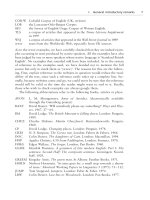An Encyclopedia of the History of Technology part 3 docx
Bạn đang xem bản rút gọn của tài liệu. Xem và tải ngay bản đầy đủ của tài liệu tại đây (189.45 KB, 10 trang )
INTRODUCTION
2
is almost impossible to imagine a citizen of an English-speaking country being in a
state of total ignorance of William the Conqueror, of Henry VIII and his six wives,
of Napoleon and the Duke of Wellington, of Lord Nelson, of Abraham Lincoln and
Gettysburg, of Kaiser Wilhelm, of Adolf Hitler and Auschwitz. These are the very
stuff and characters that make up the pages of conventional history. Yet there are also
Johann Gensfleisch zum Gutenberg, Leonardo da Vinci, McAdam and Telford, the
Stephensons and the Brunels, Edison and Parsons, Newcomen and Watt, Daimler,
Benz and Ford, Barnes Wallis, Whittle, von Braun, Cockcroft, Shockley, Turing and
von Neumann and many others. It is interesting to consider which group had the
greater influence on the lives of their contemporaries. Even more, which group has
had the more long-lasting influence on the man in the street of later generations. It is
a matter of regret that space does not allow us, in the present volume, to deal in a
biographical manner with these and the many other inventors involved, but only
with their works. To do so would require a whole shelf of books, rather than just a
single volume.
We might well question the value of studying the history of technology. One
answer is much the same as that for history as a whole. By studying the past,
one should, with wisdom, be able to observe its successes while perceiving its
mistakes. ‘Study the past, if you would divine the future,’ Confucius is said to
have written some 2500 years ago, and even if this is an apocryphal quotation,
the precept holds good. In fact it seems self-evident that, in the normal course of
events, in the process of invention or of engineering design, the inventor or
designer starts his quest with a good look at the present and the past. Inventors,
though not necessarily ill-natured, tend to be dissatisfied with things around
them. The endeavour to invent arises when their dissatisfaction becomes focused
on a single aspect of existing technology. Typically, the inventor seeks a method
of improving on past and present practice, and this is the first step in the process
of moving forward to a new solution. Thus the history of technology and the
history of invention are very much the same.
Why study the history of technology? One could argue that it is a discipline
with all the essential elements needed to give a good training to the mind, if
such an exercise be considered desirable. Then there is another school of
thought; a growing body of people find the study is its own reward. They are
willing to pursue it for the pure fun of it. Though many of them may be
professionals, they are in fact truly amateurs in the exact sense of the word.
Long may they flourish and continue to enjoy the pursuit of knowledge in this
field for its own sake.
SCIENCE AND TECHNOLOGY
It is important at the start to distinguish between science and technology, for
science as such can have no place in the present volume. Though the dividing line
BASIC TOOLS, DEVICES AND MECHANISMS
3
is sometimes imprecise, it undoubtedly exists. In our context, at least, science is the
product of minds seeking to reveal the natural laws that govern the world in which
we live and, beyond it, the laws that govern the universe. Technology, on the other
hand, seeks to find practical ways to use scientific discoveries profitably, ways of
turning scientific knowledge into utilitarian processes and devices.
It is quite clear where the line must be drawn in most cases. The steam
engine, for instance, the first source of mechanical power and the first heat
engine, was to release man from reliance on his own or animal muscles or the
fickleness of wind and water. For a short period in the seventeenth century
scientists, mostly dilettantes, took a lively interest in the possibility of
harnessing the power of steam, but little came of their curiosity. Nor did that of
certain less scientific but more practical experimenters such as Sir Samuel
Morland, ‘Magister Mechanicorum’ to King Charles II, Captain Thomas
Savery or Denis Papin, the French scientist who invented the pressure cooker
and worked for some time at the Royal Society, lead to the crucial
breakthrough. Claims may be, and have been made for any one of these to
have ‘invented’ the steam engine but, without question, it was Thomas
Newcomen, a Dartmouth ‘ironmonger’, who devised and built the world’s first
practical steam engine, which was installed for mine-pumping at Dudley Castle
in 1712. There is equally little doubt that Newcomen was a practical man, an
artisan with little or no scientific knowledge or any training in scientific
matters. Science and scientists had little direct or indirect influence on the early
development of the steam engine. The prestigious Royal Society, founded as
recently as 1662, did not even honour Newcomen.
The situation was little different when Sir Charles Parsons patented and
produced the first practical steam turbine in 1884. True, Parsons had a top-
drawer upbringing and education. Sixth son of the Earl of Rosse, he was
privately tutored until he went to Trinity College, Dublin, and then to
Cambridge University. There, the only pure science that he studied was pure
mathematics, before starting an engineering apprenticeship. This was before
there was any established School of Engineering at Cambridge, but he did
attend such few lectures that were given on Mechanisms and Applied
Mechanics. That was all the ‘scientific’ training given to the man who was to
revolutionize both marine propulsion and the electrical supply industry.
But matters are not always so clear-cut. Take horology, for instance, or
timekeeping. The men who evolved the first calendars, who observed the
difference between the twelve cycles of the moon and the one of the sun, were
astronomers, scientists. Admittedly they were working towards the practical
solutions of how to predict the seasons, the flooding of the River Nile, the
times for sowing and the time for harvest. But they were scientists. Technology
entered into the matter only when mechanical timekeeping had arrived, when
clock and watchmakers and their predecessors had devised practical
instruments to cut up the months into days, the days into hours and the hours
INTRODUCTION
4
into minutes and, later, seconds. These were technologists. They were practical
men who made their living by making instruments with which scientists and
others could tell the time.
Perhaps the matter may best be summed up by a quotation, supposedly
originating from Cape Canaveral or one of the other stations involved in
United States NASA Space Programme. One of the engineers is speaking:
‘When it works,’ he is reported to have said, ‘it’s a scientific breakthrough.
When it doesn’t, it’s those b—— engineers again.’
Purists, of course, would doubtless dispute the difference between
engineering and technology. The latter—the science of the industrial arts, as the
Concise Oxford English Dictionary puts it—includes engineering but is a much wider
concept. Engineering—mechanical, civil, electrical, chemical etc., with further
sub-divisions into smaller sectors—is defined in the same work as the
‘application of science for the control and use of power, especially by means of
mechanics’. It is but a part of technology, although a large and important part.
One further possible source of confusion exists. It is clear that the
astronomer, the man who looks through the telescope, is a scientist. On the
other hand, the scientific instrument maker, the man who made the telescope,
is a technologist. In some cases, like those of Galileo and Sir William Herschel,
they may be one and the same man. However, as space is at a premium, we
must forgo the telescope as a part of technology and consider it the prerogative
of the editor of an Encyclopaedia of the History of Science, just as we would
consider the violin and the bassoon as musical topics although the craftsmen
who originally made them were undoubtedly technologists.
THE ARCHAEOLOGICAL AGES
The neglect of technology, the near-contempt in which archaeologists and
historians seem to hold it, is all the more surprising when one considers that it
was one of the former who originated what is now the standard classification of
the archaeological ages, and which is based on technological progress. Christian
Jurgensen Thomsen, who became Curator of the Danish National Museum in
1816, first started the system that is used world-wide today. He had previously
read a work by Vedel Simonsen which stated that the earliest inhabitants of
Scandinavia had first made their tools and weapons of wood or stone, then of
copper or bronze and finally of iron. This inspired him to arrange his collections
by classifying them into the three ages of Stone, Bronze and Iron and, from
1819, visitors to the museum were confronted with this classification. It first
appeared in print in 1836, in his guidebook to the museum.
The scheme was by no means universally accepted until, in 1876, François
von Pulski, at the International Congress of Archaeology in Budapest, added a
Copper Age between the Stone and Bronze Ages and, in 1884, published his
BASIC TOOLS, DEVICES AND MECHANISMS
5
book on the Copper Age of Hungary. This added the final seal of approval
and thenceforth the world took wholeheartedly to Thomsen’s classification.
Yet although it was clearly based on the materials from which tools were made,
and such tools are the predecessors of industry, industrial archaeology and
industrial history are only grudgingly accepted and taught but sparingly in the
majority of centres of learning.
One archaeologist who was convinced that we should look upon pre-history
primarily as a history of technology was Professor V.Gordon Childe who
studied, rather than the rise and fall of civilizations, the rise and fall of
technologies—the technologies of hunting and weapon-making, of herding and
domesticating animals, of crop-growing and agriculture, of pottery and metal
working. Childe held that one should not study the palace revolutions that
enabled one pharaoh to displace another, but the technologies that enabled one
tribe or nation to overcome another in battle and the technologies that enabled
people to produce such a surplus of food in the valley of the Nile or the Tigris
or Euphrates that great states could be set up. Of recent years more and more
archaeologists have been adopting Professor Childe’s approach.
THE SEVEN TECHNOLOGICAL AGES OF MAN
When studying the history of mankind from the point of view of technological
development, it is possible to distinguish seven to some extent overlapping
ages: 1. the era of nomadic hunter-gatherers, using tools and weapons
fashioned from easily available wood, bone or stone and able to induce and
control fire; 2. the Metal Ages of the archaeologist, when increasing
specialization of tasks encouraged change in social structures; 3. the first
Machine Age, that of the first clocks and the printing press, when knowledge
began to be standardized and widely disseminated; 4. the beginnings of
quantity production when, with the early application of steam power, the
factory system began irreversibly to displace craft-based manufacture; 5. the
full flowering of the Steam Age, affecting all areas of economic and social life;
6. the rapid spread of the internal combustion engine, which within 50 years
had virtually ousted steam as a primary source of power; 7. the present
Electrical and Electronic Age, which promises to change human life more
swiftly and more radically than any of its predecessors.
THE FIRST AGE: MAN, THE HUNTER, MASTERS FIRE
The history of technology can be said to be older than man himself, for the
hominids that preceded Homo erectus and Homo sapiens were the first to use tools.
Australopithecenes, typically Taung Man, whose skull was turned up by Dr
INTRODUCTION
6
Louis Leakey and his wife Mary in 1925 in the Olduvai Gorge in Tanzania, was
one of the earliest and has been found associated with simple stone tools as well
as potentially useful flakes of stone, the by-products of the tool-making process
(see Figure 1). Australop1thecus, originating probably between two and three
million years ago, was the first of man’s predecessors to walk upright. This
ability was to lead to the whole story of technology, for it made available a pair
of forelimbs and hence the ability to grasp sticks or stones and later to fashion
them for particular purposes and to sharpen them to a cutting edge. The first of
the hominids was Ramepithecus, thought to date back as far as fourteen million
years and closely related to the great apes. However, it appears to have taken
eleven or twelve million years for the tool-making habit to emerge.
Table 1: A summary of the material ages
Note: ybp indicates years before the present. The dates given are approximate:
the same event took place in different countries at different times.
BASIC TOOLS, DEVICES AND MECHANISMS
7
The ability to fashion stone tools was followed by a further advance
otherwise unknown in the animal kingdom. No other species has the ability to
make fire. It is one of man’s most wonderful accomplishments and one which
was to lead to innumerable benefits.
‘Making’ fire is not the same as ‘using’ fire: the use of natural sources of
fire, such as volcanoes, meteorites, spontaneous chemical combustion or the
focusing of the sun’s rays through a raindrop, clearly predated the ability to
generate fire. In early tribal societies an important function was the tending of
a source of fire, started from one of the natural sources and which must, at all
costs, be kept alight, fed and nurtured. It is said that, even today, there are
Tasmanian and Andamanese tribes who have not mastered the art of making
fire but have to borrow it from their neighbours. The first hominid known to
have made fire was the Homo erectus (originally classed as Sinanthropus pekinensis)
of Choukoutien in China. Many layers of charcoal have been uncovered there
in the caves that they used, indicating intermittent occupation and fire making
over a period of many years. This activity dates from about 600,000 BC.
The uses to which fire was put were many and may be summarized as: for
warmth, for cooking, for the curing of hides, for protection in scaring off wild
animals, and as a focus for the social life of the tribe after darkness had fallen.
At a later period it was used also for hollowing out logs to make primitive
boats, and in firing pots, bricks and tiles, while the extraction of copper and
iron from their ores, the very bases of the metallurgical eras, and the
subsequent working of those metals into tools, weapons and ornaments, was
entirely dependent on fire. The making of glass objects was also based on the
control of fire.
The ability to make fire at will was thus one of the first major advances in
the early history of technology. There were two principal methods of doing so,
by impacting flint and iron or iron pyrites, and by the generation of heat by the
Figure 1: Basalt side-chopper; over 2.5 million years old from the Oldurai Gorge,
Tanzania.
After M.D.Leakey.
INTRODUCTION
8
friction of a hard stick, or fire-drill, against a softwood block, or hearth. While
the flint (silicon dioxide) method seems the more likely to have occurred by
chance and is therefore likely to be the earlier, it does require the addition of
dried grass or some other suitable tinder to make a fire. On the other hand, the
fire-drill, which would seem to imply a higher degree of intellectual capacity
for its conception, provides its own tinder from the friction of the hard, pointed
stick on the soft wood of the hearth (see Figure 2). Possibly a later
development of the fire-drill was the addition of a doughnut-shaped stone,
drilled through its centre, held in place by a tapered peg to the drill, which
would act as a flywheel by its own inertia. Some authorities have interpreted
this artefact as merely a digging stick. It does seem, however, that the makers
of so sophisticated a tool must have gone to an inordinate amount of toil and
trouble to bore out the flat, circular, stone to weight a digging stick to which a
weight could easily be attached by tying with a thong or cord.
The fire-drill was rotated simply between the two hands of the operator,
limiting the number of revolutions it made before its direction of rotation had
to be reversed. The stroke could easily be increased from the nine or ten
revolutions that would be made by a 1/4-inch diameter stick between average
hands before reversing, by a quite simple addition. This was to wind a piece of
cord or thong once round the stick and then to tie the ends to a bent piece of
springy wood in the shape of a bow. Thus evolved the bow-drill, used as much
Figure 2: Fire drills from northern Queensland Australia, Alaska and the
Kalahari.
BASIC TOOLS, DEVICES AND MECHANISMS
9
for drilling holes as for starting fires and one of the first multi-component
machines to be invented. Indeed, some archaeologists have propounded the
use of such a drill as a component of an elementary machine tool, in which a
weight and lever arm comprised the tool feed, the tool of hollow bone being
fed with powdered flint at the cutting edge, the drill being rotated by a bow.
Such a machine is purely conjectural, but the bow is known to have turned
lathes in the RomanoBritish period of the Iron Age.
The bow when used as a weapon supposedly invented by the people of
Birel-Ater in Tunisia in the middle to late Stone Age, was also the first
energystoring device. The energy of the bowman is gradually put into the bow
as it is drawn and stored until released instantaneously at the moment of
shooting. This was a considerable advance on the spear-thrower, a sling which
merely extended the leverage of a man’s arm. Bone, for example from a deer’s
antler, was used as the bow, with an animal sinew as the string, sometimes as a
substitute for a suitably flexible piece of wood.
Wood was, of course, a natural and usually easily obtained material which by
the nature of its growth would suggest itself to primitive man for many
purposes—for digging, for spears and clubs, and for use as a lever in many
situations. Bone came into service in slivers for making needles and for digging
on a grander scale as in the Neolithic flint mines such as Grime’s Grave in
Norfolk, where the quantity of flints removed suggests that they must have been
a commodity of primitive trade. The shoulder-blade of an ox is flat and splayed
out in such a way as to make an ideal natural shovel, while a part of the antler of
the red deer would serve as a suitable pick. Similar flint mines have been found
in Belgium, Sweden, France and Portugal. In some cases the shafts of such mines
are as much as thirteen metres deep and extend at the bottom into galleries
where the richest seams are to be found. Trade in these flints, sometimes in the
raw state and sometimes shaped into finished tools, was international as well as
within their countries of origin. International commerce was thus established,
probably several thousand years before the Bronze Age and, it seems likely, long
before the introduction of agriculture and settled centres of population.
Bone, ivory and horn found use for making spear-tips, fish-hooks and
harpoons, as well as needles. Fish was a valuable addition to the diet of
hunting and food-gathering peoples as it was to agricultural communities, and
fishing increased as the building of boats became possible. This appears to
have occurred about 7000 BC. Even boat-building, however, was much
dependent on the mastery of fire to hollow out logs.
The development of tools in the Stone Age
Owing to its density and hardness, stone was probably the most popular material
for tools in the Stone Age. Thanks to its durability, it is also the most common
INTRODUCTION
10
material of such tools as have survived the centuries since they were in use. The
oldest and, at the same time, the most primitive that are undoubtedly man-made,
or made by his predecessors, are the pebble tools found by Richard Leakey in
Kenya which have been dated at 2.6 million years old. These include the
characteristic core and flake tools; the flakes produced as waste in the process of
developing the core were put to good use, as many of them had sharp cutting
edges. Characteristically such core pebble tools were only flaked to produce a
sharp edge at one end. It is notable that in this, the world’s oldest industry, dating
back probably some 5 million years, ‘tools to make tools’ were included, hammer-
stones and anvil stones being found in the lowest levels at Olduvai in Tanzania.
So-called hand axes, on the other hand, were bifaced, that is to say,
sharpened by flaking all round the periphery. The development of this type of
tool is also attributed to peoples in Central Africa, supposedly dating from
about half a million years ago. This was a general purpose tool, serving not
only as an axe but also for piercing and scraping the hides of animals. Not
only pebbles were used in their manufacture: some show signs of having been
quarried from the natural rock.
Where long parallel-sided flakes were produced, usually from flint, chert
or obsidian, they represent the so-called blade-tool industries. From these
basic knife blades a number of variants have been found: gravers,
spokeshaves, saw blades, planes and drills have been identified by
palaeontologists, although the common man might have some difficulty in
distinguishing some of them. All belong to the Upper Palaeolithic period that
is, say, from 35,000 to about 13,000 years ago when hunting was still the
primary source of food.
The Mesolithic, or Middle Stone Age, lasting approximately from 12,000 to
7000 BC, saw a revolution in the making of stone tools. The techniques of
grinding and polishing, already applied to bone and ivory in Middle and Upper
Palaeolithic times, began to be used for the surfacing of stone tools. An axe with
a smooth surface would be much easier to use for felling trees, though its
advantages with some other types of tool do not seem to be so evident. Basalt
and epidiorite, finer grained igneous rocks, are more easily ground and polished
than flint and it is supposed that the technique probably originated in regions
where these rocks were in common use for tool-making. This grinding and
polishing was probably at its peak around 6000 to 5000 BC, declining in
importance after 3000 BC when copper and then bronze came into use.
The grinding and polishing process generally involved rubbing the tool
against a slab of wetted sandstone or similar hard rock, sand being used as an
abrasive powder if only a non-friable rock was available as a grinding base.
Some axes of the Neolithic and Bronze Ages, probably used for ceremonial
purposes, have a very high polish suggestive of a final burnishing with skins
and a polishing powder. These have generally been found associated with the
burials of tribal chieftains.
BASIC TOOLS, DEVICES AND MECHANISMS
11
The production of the basic core and flake tools was a skilled occupation
using one of two methods—pressure flaking or percussion flaking. In the
former, a tool of bone, stone or even wood was pressed against the core so as
to split off a flake and the process was repeated. In percussion flaking a
hammer stone was repeatedly struck against the core or against an
intermediate bone or wooden tool applied to its edge. Either process requires a
high degree of skill, acquired through long practice and much experience and,
in the case of the more complex shapes such as barbed and tanged
arrowheads, indicates a degree of specialization at an early date.
The adze, roughly contemporary with the hafted axe, similarly developed
into a polished tool about 6000 BC in the Middle East with the general adoption
of agriculture as a method of food production. The spokeshave is also of this
period; of course, it was not at that time used for wheel spokes but more for
refining spear shafts, needles, awls, bows and the like, in wood or bone.
It is interesting to note that the impulse to create and the ability to produce
images of animals (including men and women) seems to date from late
Palaeolithic times at least, that is before about 12,000 BC. Relief carving on
cave walls, modelling in clay and powdered bone paste, and cave wall painting
were all included in the artistic activities of the Gravettian and Magdelenian
cultures that were established in the Dordogne region of France. Black oxide of
manganese and the ochres or red and yellow oxides of iron, generally ground
to a powder and mixed with some fatty medium, were the colours generally
used and probably represent man’s first excursions into the world of chemistry
as well as that of art. Mammoth, woolly rhinoceros, bison, reindeer, horse,
cave lion and bear have all been found in these paintings, mostly of men
fighting with bows and arrows, credited to the people of Bir-el-Ater, Tunisia, in
the Middle to Late Palaeolithic period. Another rock painting in Spain shows a
woman collecting honey with a pot or basket and using a grass rope ladder,
another early invention extant in this period.
THE SECOND AGE: THE FARMER, THE SMITH AND THE
WHEEL
The change from nomadic hunter to settled agricultural villager did not
happen overnight, even over centuries. It must have taken several thousand
years. It started some time about 10,000 BC, when a great event took place—
the end of the last Ice Age when the melting ice flooded the land and brought
to life a host of plants that had lain dormant in seeds. Among these was wild
wheat as well as wild goat grass. It was the accidental cross-fertilization of these
that led to the much more fruitful bread wheat, probably the first plant to be
sown as a crop, which was harvested with a horn-handled sickle with









